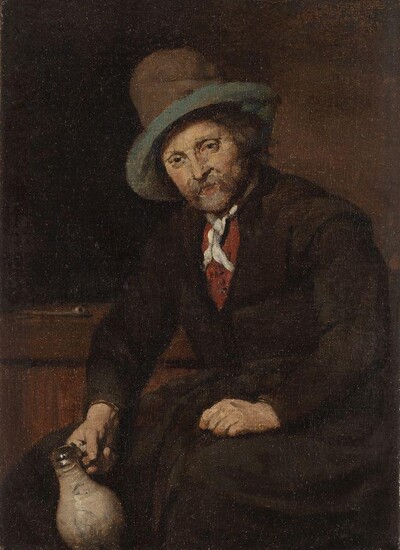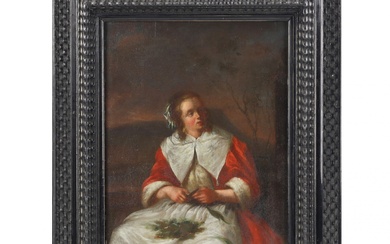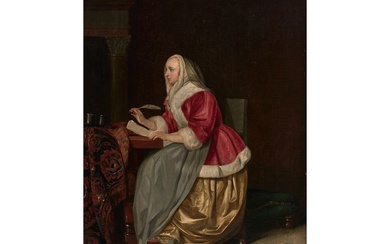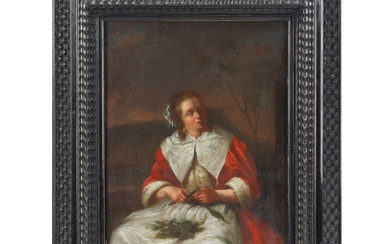Gabriel Metsu, Dutch 1629-1667- The drinker; oil on canvas laid down on panel, bears traces of initials ‘G M’ (upper right), bears old inscribed label on the reverse, 17.7 x 13 cm. Provenance: Collection of M. le Chevalier V. de...
Gabriel Metsu,
Dutch 1629-1667-
The drinker;
oil on canvas laid down on panel, bears traces of initials ‘G M’ (upper right), bears old inscribed label on the reverse, 17.7 x 13 cm.
Provenance:
Collection of M. le Chevalier V. de Stuers, Directeur General des Beaux-Arts, The Hague.;
Collection of Mrs W. E. Gatacre Jonkvrouwe de Stuers, Kasteel de Wiersse, Vorden, Holland;
with Alfred Brod Gallery, London.;
Private Collection, UK, since 1966.;
By descent.
Literature:
Catalogue of the Collection of M. le Chevalier V. de Stuers, Directeur General des Beaux-Arts, The Hague, 1898.;
Hofstede de Groot, ‘A Catalogue Raisonne of the Most Eminent Dutch Painters of the Seventeenth Century’, Vol. I, 1908, no.196.;
Victor de Stuers, ‘Manuscript Catalogue of his Collection’, 1915, no.303.;
Franklin W. Robinson, ‘Gabriel Metsu (1629-1667), A Study of His Place in Dutch Genre Painting of the Golden Age’, New York, 1974, p.16, fig.2 (illustrated).;
Arthur K. Wheelock Jr., ‘Review of Robinson 1974,’ Art Bulletin 58, 1976, p.457.;
Adriaan Waiboer, ‘Gabriel Metsu’, New Haven and London, 2010, p.319, no.D-23 (illustrated).
Note: Dr Adriaan Waiboer, to whom we are grateful, has confirmed the attribution of the present lot after first-hand inspection, and has suggested its dating to the mid-1650s. Having initially rejected the attribution on the basis of black and white photographs (see A. Waiboer ‘Gabriel Metsu’, 2010, no.D-23), he has revised his opinion.
Metsu was one of the leading figures in the founding of the Leiden Guild of Saint Luke, of which he became a member in 1648. Between circa 1650-2, the guild records show that Metsu was absent, and he probably spent part of this time in Utrecht. By 1657 he was living permanently in Amsterdam where he died prematurely at the age of 39. It was in the years 1653-54 that Metsu began to distance himself from the influence of Nicolaus Knupfer (c.1603-1655/60), the Utrecht painter who specialised in biblical and mythological subjects, and began to seek inspiration from a wider variety of artists. The canvas, thematically unrelated to and much smaller than the Knupferian paintings he had executed in the early 1650s, is evidence of the artist’s change of direction, and belongs to a long tradition of Dutch and Flemish images of men drinking and smoking in a tavern — paintings commonly seen in collectors’ homes, the shops of art dealers, and the workshops of other painters. The tone is meditative, rather than didactic or narrative, and there is a new emphasis on the rendering of everyday objects – the exquisitely rendered earthenware jug, for example, and the pipe – which suggests Metsu’s imagination may have been captured by the still life works of Leiden artists, such as Jan Davidsz. de Heem (1606-1683/4) or Jan Lievens (1607-1674). Metsu's pictures were sought after by the urban elite in the cities where he worked, Leiden and Amsterdam. Yet he also had several noble patrons, including August II, King of Poland and Elector of Saxony, who owned an unidentified 'tobacco smoker' (A. Waiboer, p.119). In the 18th century, his fame continued to grow and his paintings were more desirable than those of his contemporary Johannes Vermeer (1632-1675), with whom he exchanged mutual influence (A. Waiboer, pp.29-51). For a comparable composition by the artist, though on copper, see his ‘Smoker seated at a table’, now in private hands, which was offered at Sotheby’s, London, 5 December 2007, lot 8 (see A. Waiboer, “Smoker Seated at a Table” (2017). In The Leiden Collection Catalogue, 3rd ed. Edited by Arthur K. Wheelock Jr. and Lara Yeager-Crasselt. New York, 2020).
Please refer to department for condition report
View it on
Sale price
Estimate
Reserve
Time, Location
Auction House
Gabriel Metsu,
Dutch 1629-1667-
The drinker;
oil on canvas laid down on panel, bears traces of initials ‘G M’ (upper right), bears old inscribed label on the reverse, 17.7 x 13 cm.
Provenance:
Collection of M. le Chevalier V. de Stuers, Directeur General des Beaux-Arts, The Hague.;
Collection of Mrs W. E. Gatacre Jonkvrouwe de Stuers, Kasteel de Wiersse, Vorden, Holland;
with Alfred Brod Gallery, London.;
Private Collection, UK, since 1966.;
By descent.
Literature:
Catalogue of the Collection of M. le Chevalier V. de Stuers, Directeur General des Beaux-Arts, The Hague, 1898.;
Hofstede de Groot, ‘A Catalogue Raisonne of the Most Eminent Dutch Painters of the Seventeenth Century’, Vol. I, 1908, no.196.;
Victor de Stuers, ‘Manuscript Catalogue of his Collection’, 1915, no.303.;
Franklin W. Robinson, ‘Gabriel Metsu (1629-1667), A Study of His Place in Dutch Genre Painting of the Golden Age’, New York, 1974, p.16, fig.2 (illustrated).;
Arthur K. Wheelock Jr., ‘Review of Robinson 1974,’ Art Bulletin 58, 1976, p.457.;
Adriaan Waiboer, ‘Gabriel Metsu’, New Haven and London, 2010, p.319, no.D-23 (illustrated).
Note: Dr Adriaan Waiboer, to whom we are grateful, has confirmed the attribution of the present lot after first-hand inspection, and has suggested its dating to the mid-1650s. Having initially rejected the attribution on the basis of black and white photographs (see A. Waiboer ‘Gabriel Metsu’, 2010, no.D-23), he has revised his opinion.
Metsu was one of the leading figures in the founding of the Leiden Guild of Saint Luke, of which he became a member in 1648. Between circa 1650-2, the guild records show that Metsu was absent, and he probably spent part of this time in Utrecht. By 1657 he was living permanently in Amsterdam where he died prematurely at the age of 39. It was in the years 1653-54 that Metsu began to distance himself from the influence of Nicolaus Knupfer (c.1603-1655/60), the Utrecht painter who specialised in biblical and mythological subjects, and began to seek inspiration from a wider variety of artists. The canvas, thematically unrelated to and much smaller than the Knupferian paintings he had executed in the early 1650s, is evidence of the artist’s change of direction, and belongs to a long tradition of Dutch and Flemish images of men drinking and smoking in a tavern — paintings commonly seen in collectors’ homes, the shops of art dealers, and the workshops of other painters. The tone is meditative, rather than didactic or narrative, and there is a new emphasis on the rendering of everyday objects – the exquisitely rendered earthenware jug, for example, and the pipe – which suggests Metsu’s imagination may have been captured by the still life works of Leiden artists, such as Jan Davidsz. de Heem (1606-1683/4) or Jan Lievens (1607-1674). Metsu's pictures were sought after by the urban elite in the cities where he worked, Leiden and Amsterdam. Yet he also had several noble patrons, including August II, King of Poland and Elector of Saxony, who owned an unidentified 'tobacco smoker' (A. Waiboer, p.119). In the 18th century, his fame continued to grow and his paintings were more desirable than those of his contemporary Johannes Vermeer (1632-1675), with whom he exchanged mutual influence (A. Waiboer, pp.29-51). For a comparable composition by the artist, though on copper, see his ‘Smoker seated at a table’, now in private hands, which was offered at Sotheby’s, London, 5 December 2007, lot 8 (see A. Waiboer, “Smoker Seated at a Table” (2017). In The Leiden Collection Catalogue, 3rd ed. Edited by Arthur K. Wheelock Jr. and Lara Yeager-Crasselt. New York, 2020).
Please refer to department for condition report






